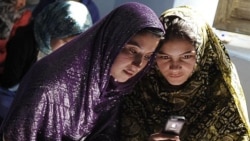The best measure of U.S. efforts in Afghanistan, said U.S. Special Representative for Afghanistan and Pakistan James Dobbins, “is not what we put into it or the direct outputs, but rather the outcomes.”
“I believe Afghanistan may actually be the most successful international effort at reconstruction in a conflict or post-conflict country over the last quarter century,” said Mr. Dobbins.
Indeed, life expectancy in Afghanistan has increased from 44 years to 60 years, and that’s in a country that’s still at war. Afghanistan has gone from having the lowest literacy rate in the entire world, around 15 percent back in 2001, to 33 percent literacy today and to 60 percent literacy by 2025 if current trends hold.
Afghanistan is also more connected and informed than ever before. In 2001 there was one state owned TV station. Today 75 television stations, nearly all of them independent, compete for viewers across the country. There are also 18 million telephone lines, up from 40,000 in 2001. Cellphone coverage has gone from zero to 90 percent of the country.
On the military front, the United States and our ISAF coalition partners are transitioning from a combat role to an advisory and assistance role. The United States is committed to continuing to support a fully sovereign, democratic and united Afghanistan. As President Barack Obama stated, the U.S. has two goals: number one, to disrupt, dismantle and defeat Al Qaida and ensure that Afghanistan can never again become a safe haven for terrorists; and two, to train, assist and advise Afghan forces so they can maintain Afghanistan’s security.
While the United States continues to help Afghans secure their country, the U.S. is also supporting an Afghan-led reconciliation process designed to find a political solution to the conflict with the Taliban and bring peace to the country. But for the coming year, the main priority will be the political transition that will occur when Afghan presidential elections occur next spring, which will mark the first transfer of power from one freely elected government to another in the Afghanistan’s history.
Like any developing country emerging from conflict, there will be challenges. Though substantial progress has been made since 2001, Afghanistan will require international support for some time. But there is already much that the people of Afghanistan and the United States can be proud of.
“I believe Afghanistan may actually be the most successful international effort at reconstruction in a conflict or post-conflict country over the last quarter century,” said Mr. Dobbins.
Indeed, life expectancy in Afghanistan has increased from 44 years to 60 years, and that’s in a country that’s still at war. Afghanistan has gone from having the lowest literacy rate in the entire world, around 15 percent back in 2001, to 33 percent literacy today and to 60 percent literacy by 2025 if current trends hold.
Afghanistan is also more connected and informed than ever before. In 2001 there was one state owned TV station. Today 75 television stations, nearly all of them independent, compete for viewers across the country. There are also 18 million telephone lines, up from 40,000 in 2001. Cellphone coverage has gone from zero to 90 percent of the country.
On the military front, the United States and our ISAF coalition partners are transitioning from a combat role to an advisory and assistance role. The United States is committed to continuing to support a fully sovereign, democratic and united Afghanistan. As President Barack Obama stated, the U.S. has two goals: number one, to disrupt, dismantle and defeat Al Qaida and ensure that Afghanistan can never again become a safe haven for terrorists; and two, to train, assist and advise Afghan forces so they can maintain Afghanistan’s security.
While the United States continues to help Afghans secure their country, the U.S. is also supporting an Afghan-led reconciliation process designed to find a political solution to the conflict with the Taliban and bring peace to the country. But for the coming year, the main priority will be the political transition that will occur when Afghan presidential elections occur next spring, which will mark the first transfer of power from one freely elected government to another in the Afghanistan’s history.
Like any developing country emerging from conflict, there will be challenges. Though substantial progress has been made since 2001, Afghanistan will require international support for some time. But there is already much that the people of Afghanistan and the United States can be proud of.

















